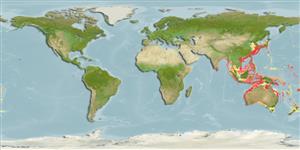Teleostei (teleosts) >
Acropomatiformes (Oceanic basses) >
Banjosidae (Banjofishes)
Etymology: banjos: Subspecific name from Latin 'brevispinis' meaning short-spine, referring the relatively short dorsal-fin spines when compared with B. b. banjos..
More on author: Richardson.
Environment: milieu / climate zone / depth range / distribution range
Ecology
Marine; demersal; depth range 50 - 400 m (Ref. 11230). Tropical
Indo-West Pacific: from the southeastern Indian Ocean, including the west coast of Australia and Indonesia to northwestern Pacific, ranging from the South China Sea north to Japan.
Size / Weight / Age
Maturity: Lm ? range ? - ? cm
Max length : 20.0 cm SL male/unsexed; (Ref. 559)
This species is distinguished from its congeners by the following set of characters: 0-22 serrae on ventral margin of lacrimal; in specimens 15.0-20.0 cm SL, 14-36 serrae on cleithrum; in specimens >10.0 cm SL, head length 33.2-39.6 (mean 36.5) % of SL, orbit diameter 11.2-16.6 (14.1) % of SL, vertical orbit diameter 9.5-14.9 (13.5) % of SL; least interorbital width 5.8-10.3 (mean 7.3) % of SL; postorbital length 11.5-15.7 (mean 13.3) % of SL; in specimens > 10.0 cm SL pre-pelvic-fin length 38.0-44.7 (mean 41.5) % of SL; first dorsal-fin spine length 4.5-11.7 (6.7) % of SL; second dorsal-fin spine length 11.2-22.7 (16.1) % of SL; in juveniles <7.0 cm SL, spine at angle of preopercle relatively short, moderately serrated and membrane of spinous dorsal-fin with broad central translucent area (Ref. 116322).
Life cycle and mating behavior
Maturity | Reproduction | Spawning | Eggs | Fecundity | Larvae
Paxton, J.R., D.F. Hoese, G.R. Allen and J.E. Hanley, 1989. Pisces. Petromyzontidae to Carangidae. Zoological Catalogue of Australia, Vol. 7. Australian Government Publishing Service, Canberra, 665 p. (Ref. 7300)
IUCN Red List Status (Ref. 130435)
Threat to humans
Harmless
Human uses
Fisheries: minor commercial
More information
Common namesSynonymsMetabolismPredatorsEcotoxicologyReproductionMaturitySpawningSpawning aggregationFecundityEggsEgg development
ReferencesAquacultureAquaculture profileStrainsGeneticsElectrophoresesHeritabilityDiseasesProcessingNutrientsMass conversion
Tools
Special reports
Download XML
Internet sources
Estimates based on models
Preferred temperature (Ref.
123201): 13.6 - 26.5, mean 19.7 °C (based on 395 cells).
Phylogenetic diversity index (Ref.
82804): PD
50 = 0.7500 [Uniqueness, from 0.5 = low to 2.0 = high].
Bayesian length-weight: a=0.01995 (0.00906 - 0.04395), b=3.01 (2.83 - 3.19), in cm total length, based on all LWR estimates for this body shape (Ref.
93245).
Trophic level (Ref.
69278): 4.0 ±0.67 se; based on food items.
Fishing Vulnerability (Ref.
59153): Low vulnerability (14 of 100).
